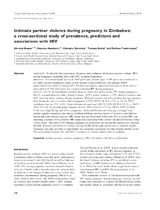Intimate partner violence during pregnancy in Zimbabwe: across-sectional study of prevalence, predictors and associations with HIV

View/
Date
2013Author
Shamu, Simukai
Abrahams, Naeemah
Zarowsky, Christina
Shefer, Tamara
Temmerman, Marleen
Metadata
Show full item recordAbstract
objective To describe the occurrence, dynamics and predictors of intimate partner violence (IPV)
during pregnancy, including links with HIV, in urban Zimbabwe.
methods A cross-sectional survey of 2042 post-natal women aged 15–49 years was conducted in
six public primary healthcare clinics in low-income urban Zimbabwe. An adapted WHO
questionnaire was used to measure IPV. Multivariate logistic regression was used to assess factors
associated with IPV and severe (six or more episodes) IPV during pregnancy.
results 63.1% of respondents reported physical, emotional and/or sexual IPV during pregnancy:
46.2% reported physical and/or sexual violence, 38.9% sexual violence, 15.9% physical violence and
10% reported severe violence during pregnancy. Physical violence was less common during pregnancy
than during the last 12 months before pregnancy (15.9% [95% CI 14.3–17.5] vs. 21.3% [95%
confidence interval 19.5–23.1]). Reported rates of emotional (40.3% [95% CI 38.1–42.3] vs. 44.0%
[95% CI 41.8–46.1]) and sexual violence (35.6% [95% CI 33.5–37.7] vs. 38.9% [95% CI 36.8–
41.0]) were high during and before pregnancy. Associated factors were having a younger male
partner, gender inequities, past abuse, problem drinking, partner control of woman’s reproductive
health and risky sexual practices. HIV status was not associated with either IPV or severe IPV, but
reporting a partner with a known HIV status was associated with a lower likelihood of severe abuse.
conclusion The rates of IPV during pregnancy in Zimbabwe are among the highest ever reported
globally. Primary prevention of violence during childhood through adolescence is urgently needed.
Antenatal care may provide an opportunity for secondary prevention but this requires further work.
The relationship between IPV and HIV is complex in contexts where both are endemic.
